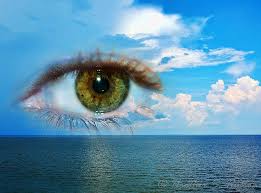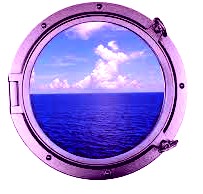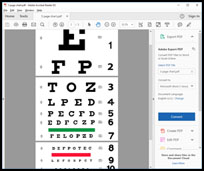When I first started studying vision improvement, and examining my own visual habits and ways of thinking, I realized I was expecting blur. Before I looked more than a few feet away, I anticipated the view being fuzzy, if not completely indecipherable. Dr. Bates wrote about using memory and imagination to help our vision, and I was using it to hold mine back. It’s as if I was telling my eyes and brain “You won’t see very well, so don’t even try to focus”. Then my obedient visual system followed this direction.

At first I didn’t understand about imagining clarity. I’d been myopic since I was a small child, and wasn’t even sure what “clarity” looked like, unless it was the sharp brittle over-focused clarity from new stronger eyeglasses, which never felt good or natural. Me, imagine clarity? You might as well ask a homeless person to imagine he lives in a palace with servants, I thought darkly. Yes, I did feel like a victim, a mindset which is not conducive to healing and growth!
It took me a while to understand that “imagining” in this context didn’t mean wishing and hoping for clarity to be bestowed on me from some fairy godmother or angel. I now know it comes from within me, after I settle my busy mind and get quiet, then visualize whatever is blurry as being clearer. If I see something blurry, I have gradually trained myself to shut my eyes, breathe deeply, then see the scene internally in as much clear detail as I can come up with. Often when I open my eyes again, the scene is clearer.

Whether you’re looking at something with your eyes open, or examining the images in your dreams, or remembering an incident from yesterday or years ago, your brain is doing the same thing. Think about that for a minute. Seeing is in the brain, not in the eyes! Memory and dreaming and open-eyed sight all exercise the same neural pathways in our brain, transforming those random colors and shapes into objects and faces we recognize, so we can make sense of our world.
When I finally stopped avoiding the dreaded eye chart (I had expected it to just tell me how poor my eyesight was), I played with this imagination technique a lot. If I couldn’t make out a letter on the chart clearly, I would close my eyes and imagine the letter I thought it was, as clearly as I could. When I opened my eyes, it was either clearer (if I had imagined the correct letter) or even more blurry if I had guessed wrong. Then it was time for another guess, and another try.
Since I’ve always had rich vivid dreams and a fertile imagination, applying this technique to vision improvement seems natural to me. What could it be that I see? Is that what it is, or that? If I don’t put any pressure on myself to “get it right”, this can be a fun game, just looking and exploring, like discovering a new world. Anything is possible, and I could spot something beautiful or fascinating at any time, if I merely look.

I wore strong glasses, then contact lenses, from age 5 into my 40s. While making many mistakes, eventually l learned how to improve the way I use my eyes and to see in a more relaxed, healthy manner. It is my pleasure to coach others to do the same. Visit me at https://NancyLNeff.com.

